American actor, comedian, director, producer, screenwriter, and stunt performer Harold Lloyd (1893-1971) is best known for his silent comedies. He ranks alongside Charlie Chaplin and Buster Keaton as one of the three most popular and influential comedians of silent film. Between 1914 and 1947, Lloyd made nearly 200 comedies, often as a bespectacled 'Glass' character, a resourceful, success-seeking go-getter who was perfectly in tune with the 1920s-era United States. His films frequently contained 'thrill sequences' of extended chase scenes and daredevil physical feats. A classic is Lloyd hanging from the hands of a clock high above the street in Safety Last! (1923).
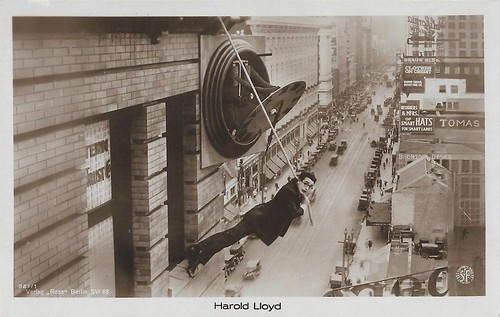
German postcard by Ross Verlag, no. 821/1, 1925-1926. Photo: Distr. S.F. (Südfilm A.G.). Harold Lloyd in the classic scene in Safety Last! (Fred Neymeyer, Sam Taylor, 1923). The street below is Los Angeles' Broadway, behind the clock is the still extant building of Hamburgers/ May Department Store. The clock itself was a set, built on the top of the building of 908 S. Broadway.

Italian postcard by G.B. Falci Editore, Milano, no. 276. Photo: Paramount. Harold Lloyd and Jobyna Ralston in The Kid Brother (Ted Wilde, J.A. Howe, 1927).

German postcard by Ross Verlag, no. 4339/1, 1929-1930. Photo: Paramount. Publicity still for Speedy (Ted Wilde, 1928).

German postcard by Ross Verlag, no. 4607/2, 1929-1930. Photo: Paramount. Harold Lloyd in Speedy (Ted Wilde, 1928).

German postcard by Ross Verlag, Foreign, no. 1485/2, 1927-1928. Photo: Paramount / Parufamet.

Italian postcard by Ed. A. Traldi, Milano, no. 78.
Harold Clayton Lloyd was born in 1893 in Burchard, Nebraska, the son of James Darsie Lloyd and Sarah Elisabeth Fraser. In 1910, after his father had several business ventures fail, Lloyd's parents divorced and his father moved with his son to San Diego, California. Lloyd had acted in theatre since he was a child, and in San Diego, he received his stage training at the School of Dramatic Art and began acting in one-reel film comedies around 1912. Lloyd worked with Thomas Edison's motion picture company, and his first role was a bit part as a Yaqui Indian in The Old Monk's Tale (J. Searle Dawley, 1913).
At the age of 20, Lloyd moved to Los Angeles and took up roles in several Keystone comedies. He was also hired by Universal Studios as an extra. Lloyd began collaborating with his friend Hal Roach who had formed his own studio in 1913. They created Will E. Work and then Lonesome Luke, variations of Charles Chaplin's Little Tramp character.
In 1914, Lloyd hired Bebe Daniels as a supporting actress. The two were involved romantically and were known as 'The Boy and The Girl'. In 1919, she left him after it became apparent he was unable to make a commitment, and she pursued her dramatic aspirations. Later that year, Lloyd replaced Daniels with Mildred Davis, whom he would marry in 1923.
By 1918, Lloyd and Roach had begun to develop a new character beyond an imitation of their contemporaries. Harold Lloyd would move away from tragicomic personas and portray an everyman with unwavering confidence and optimism. The persona Lloyd referred to as his 'Glass' character was a much more mature comedy character with greater potential for sympathy and emotional depth, and was easy for audiences of the time to identify with. To create his new character, Lloyd donned a pair of lensless horn-rimmed eyeglasses but wore normal clothing. Previously, he had worn a fake moustache and ill-fitting clothes as the Chaplinesque Lonesome Luke.
In August 1919, while posing for some promotional still photographs in the Los Angeles Witzel Photography Studio, he was seriously injured holding a prop bomb thought merely to be a smoke pot. It exploded and mangled his right hand, causing him to lose a thumb and forefinger. The blast was severe enough that the cameraman and prop director nearby were also seriously injured. Lloyd was in the act of lighting a cigarette from the fuse of the bomb when it exploded, also badly burning his face and chest and injuring his eye. Despite the proximity of the blast to his face, he retained his sight.
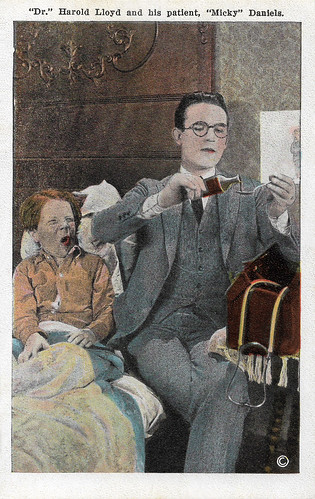
American postcard by Postcard Co., California, Los Angeles. Photo: Glen G. Stone, Los Angeles. Harold Lloyd and Mickey Daniels in Dr. Jack (Fred C. Newmeyer, Sam Taylor, 1922). Captions: "Dr." Harold Lloyd and his patient, "Mickey" Daniels. (front) Showing Harold Lloyd in the role of a doctor who "dispenses happiness". Both he and his patient "look their parts". For the freckled youngster, the happiness has evidently to come after the dose.

Italian postcard by Casa Editrice Ballerini & Fratini, Firenze (B.F.F.), no. 446. Photo: Paramount. Publicity still for Why Worry (Fred C. Newmeyer, Sam Taylor, 1923) with Jobyna Ralston.

German postcard by Edition Tushita / AKG, Berlin, no. B 514. Harold Lloyd in Safety Last (Fred C. Newmeyer, Sam Taylor, 1923).

Dutch postcard in the Emotifs series by Catch Publishing, Utrecht, no. PC 10159. Photo: Bettmann Archive / Paramount. Harold Lloyd in Safety Last (Fred C. Newmeyer, Sam Taylor, 1923).

Dutch postcard by Nederlandse Bioscoop Trust. Photo: Paramount. Harold Lloyd in Safety Last (Fred C. Newmeyer, Sam Taylor, 1923).
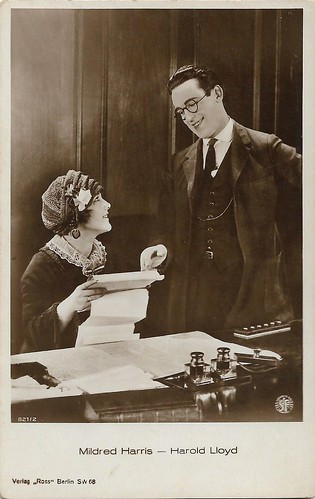
German postcard by Ross Verlag, no. 821/2, 1925-1926. Photo: S.F. (Südfilm A.G.). This postcard, with a picture from Safety Last (Fred Newmeyer, Sam Taylor, 1923), erroneously mentions the actress as Mildred Harris, while she really is Mildred Davis, Lloyd's wife. Many sources today still confuse the two actresses.
Beginning in 1921, Harold Lloyd and Hal Roach moved from shorts to feature-length comedies. These included the acclaimed Grandma's Boy, which pioneered the combination of complex character development and film comedy, and the highly popular Safety Last! (Fred C. Newmeyer, Sam Taylor, 1923), which cemented Lloyd's stardom, and Why Worry? (Fred C. Newmeyer, Sam Taylor, 1923).
Lloyd and Roach parted ways in 1924, and Lloyd became the independent producer of his own films. These included his most accomplished mature features Girl Shy (Fred C. Newmeyer, Sam Taylor, 1924), The Freshman (Fred C. Newmeyer, Sam Taylor, 1925) - his highest-grossing silent feature, The Kid Brother (Ted Wilde, J.A. Howe, 1927), and Speedy (Ted Wilde, 1928), his final silent film.
Welcome Danger (Clyde Bruckman, 1929) was originally a silent film, but Lloyd decided late in the production to remake it with dialogue. All of these films were enormously successful and profitable, and Lloyd would eventually become the highest-paid film performer of the 1920s. Although Lloyd's individual films were not as commercially successful as Charles Chaplin's on average, he was far more prolific (releasing 12 feature films in the 1920s while Chaplin released just four) and made more money overall ($15.7 million, opposite Chaplin's $10.5 million).
The huge financial success of Welcome Danger proved that audiences were eager to hear Lloyd's voice on film. Lloyd's rate of film releases, which had been one or two a year in the 1920s, slowed to about one every two years until 1938. The films released during this period were: Feet First (Clyde Bruckman, 1930), with a similar scenario to Safety Last which found him clinging to a skyscraper at the climax; Movie Crazy (Clyde Bruckman, 1932) with Constance Cummings; The Cat's-Paw (Sam Taylor, 1934), which was a dark political comedy and a big departure for Lloyd; and The Milky Way (Leo McCarey, 1936), which was Lloyd's only attempt at the fashionable genre of the screwball comedy film.
However, his go-getting screen character was out of touch with Great Depression movie audiences of the 1930s. As the length of time between his film releases increased, his popularity declined, as did the fortunes of his production company. His final film of the decade, Professor Beware (Elliott Nugent, 1938), was made by the Paramount staff, with Lloyd functioning only as actor and partial financier.

German postcard by Ross Verlag, no. 821/4, 1925-1926. Photo: S.F. (Südfilm A.G.). This postcard, with a picture from Safety Last! (Fred Neymeyer, Sam Taylor, 1923), erroneously mentions the actress as Mildred Harris, while she really is Mildred Davis.
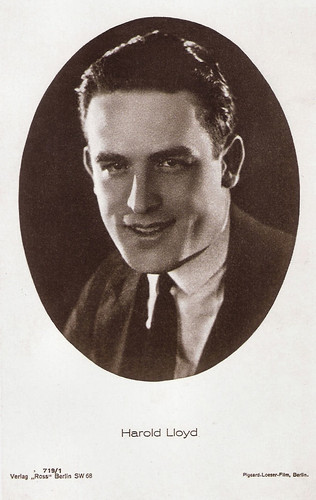
German postcard by Ross Verlag, no. 719/1, 1925-1926. Photo: Pigeard-Loeser-Film, Berlin.
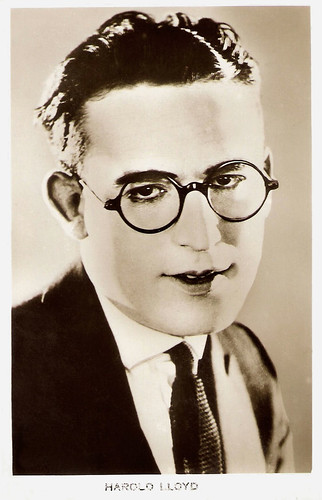
British Real Photograph postcard.
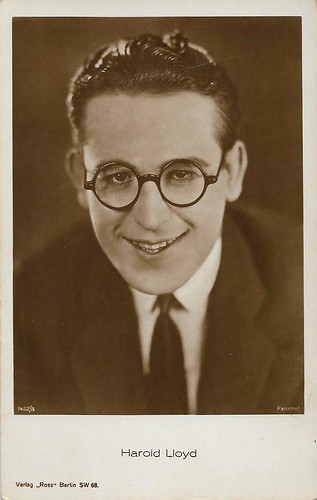
German postcard by Ross Verlag, no. 1422/3, 1927-1928. Photo: Fanamet.

Swiss-German-British postcard by News Productions, Baulmes / Filmwelt Berlin, Bakede / News Productions, Stroud, no. 56544. Photo: Collection Cinémathèque Suisse, Lausanne. Harold Lloyd in Hot Water (Sam Taylor, Fred Newmeyer, 1924) by Harold Lloyd Corporation and Pathé Exchange.

German postcard by Ross Verlag, Foreign, no. 1522/2, 1927-1928. Photo: Paramount / Parufamet. Publicity still for The Freshman (Fred C. Newmeyer, Sam Taylor, 1925).
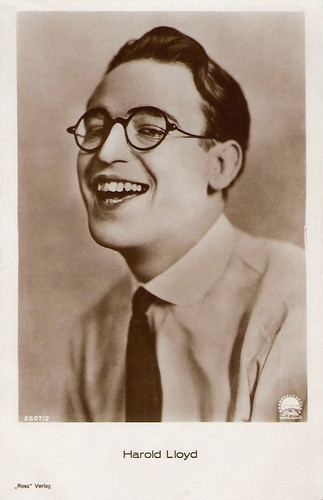
German postcard by Ross Verlag, no. 3507/2, 1928-1929. Photo: Paramount.
In 1937, Harold Lloyd sold the land of his studio, Harold Lloyd Motion Picture Company, to The Church of Jesus Christ of Latter-day Saints. The location is now the site of the Los Angeles, California Temple.
Lloyd produced two comedies for RKO: A Girl, a Guy, and a Gob (Richard Wallace, 1941) with Lucille Ball, and a Kay Kyser vehicle, My Favorite Spy (Tay Garnett, 1942), which must have looked good on paper but went nowhere at the box office.
He retired from the screen until an additional starring appearance in The Sin of Harold Diddlebock (Preston Sturges, 1947), an ill-fated homage to Lloyd's career, financed by Howard Hughes. This film had the inspired idea of following Harold's Jazz Age optimistic character from The Freshman into the Great Depression years. Diddlebock opened with footage from The Freshman (for which Lloyd was paid a royalty of $50,000, matching his actor's fee), and Lloyd was sufficiently youthful-looking to match the older scenes quite well.
Lloyd and Sturges had different conceptions of the material and fought frequently during the shoot. The finished film was released briefly in 1947, then shelved by producer Hughes. Hughes issued a recut version of the film in 1951 through RKO under the title Mad Wednesday. Lloyd sued Howard Hughes, the California Corporation and RKO for damages to his reputation "as an outstanding motion picture star and personality", eventually accepting a $30,000 settlement.
In October 1944, Lloyd emerged as the director and host of The Old Gold Comedy Theater, an NBC radio anthology series, after Preston Sturges, who had turned the job down, recommended him for it. The show presented half-hour radio adaptations of recently successful film comedies, beginning with Palm Beach Story with Claudette Colbert and Robert Young and ending in June 1945 with an adaptation of Tom, Dick and Harry, featuring June Allyson. The show was not renewed for the following season.

French postcard by Editions Cinémagazine, no. 228. Photo: Gene Kornman.

Austrian postcard by Iris Verlag, no. 5088. Photo: Paramount.


German postcard by Ross Verlag, no. 3211/1, 1928-1929. Photo: Paramount.

German postcard by Ross Verlag Foreign, no. 3801/1, 1928-1929. Photo: Paramount.

German postcard by Ross Verlag, no. 4959/1, 1929-1930. Photo: Paramount.

German postcard by Ross Verlag, no. 4607/1, 1929-1930. Photo: Paramount. Harold Lloyd and Ann Christy in Speedy (Ted Wilde, 1928). Collection: Geoffrey Donaldson Institute.
Harold Lloyd remained involved in a number of other interests, including civic and charity work. He appeared as himself on several television shows during his retirement, such as Ed Sullivan's variety show Toast of the Town (1949 and 1958). He appeared as the Mystery Guest on What's My Line? (1953), and twice on This Is Your Life: in 1954 for Mack Sennett, and again in 1955, on his own episode.
In 1953, Lloyd received an Academy Honorary Award for being a "master comedian and good citizen". He studied colours and microscopy, and was very involved with photography, including 3D photography and colour film experiments. He became known for his nude photographs of models, such as Bettie Page and stripper Dixie Evans, for several men's magazines. He also took photos of Marilyn Monroe lounging at his pool in a bathing suit, which were published after her death. In 2004, his granddaughter Suzanne produced a book of selections from his photographs, 'Harold Lloyd's Hollywood Nudes in 3D!'
Lloyd also provided encouragement and support for several younger actors, such as Debbie Reynolds, Robert Wagner, and particularly Jack Lemmon, whom Harold declared as his own choice to play him in a movie of his life and work. In the early 1960s, Lloyd produced two compilation films, featuring scenes from his old comedies, Harold Lloyd's World of Comedy (Harold Lloyd, 1962) and The Funny Side of Life (Harry Kerwin, 1963). The first film premiered at the 1962 Cannes Film Festival, where Lloyd was fêted as a major rediscovery. The renewed interest in Lloyd helped restore his status among film historians.
Lloyd and Mildred Davis had two children together: Gloria Lloyd (1923–2012) and Harold Clayton Lloyd Jr. (1931–1971). They also adopted Gloria Freeman (1924–1986) in 1930, whom they renamed Marjorie Elizabeth Lloyd but was known as Peggy for most of her life. Lloyd discouraged Davis from continuing her acting career. He later relented but by that time her career momentum was lost.
Davis died from a heart attack in 1969, two years before Lloyd died at age 77 from prostate cancer, at his Greenacres home in Beverly Hills, California. He was interred in a crypt in the Great Mausoleum at Forest Lawn Memorial Park Cemetery in Glendale, California. In 1990, Kevin Brownlow and David Gill produced the documentary, Harold Lloyd: The Third Genius. Composer Carl Davis wrote a new score for Safety Last!, which he performed live during a showing of the film with the Royal Scottish National Orchestra to great acclaim in 1993. The Brownlow and Gill documentary created a renewed interest in Lloyd's work in the United States, but the films were largely unavailable. Criterion Collection has since acquired the home video rights to the Lloyd Library and has released Safety Last!, The Freshman and Speedy.
Austrian postcard by Iris Verlag, no. 5649. Photo: Paramount. Harold Lloyd in The Kid Brother (Ted Wilde, 1927).
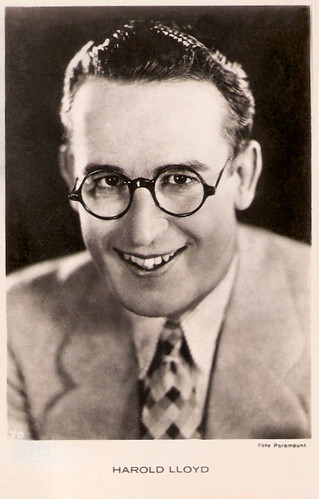
Dutch postcard, no. 76. Photo: Paramount.

French postcard by A.N., Paris, no. 430. Photo: Paramount. Publicity still for Speedy (Ted Wilde, 1928).

French postcard in the Burelesques series by Librairie de la Fontaine, Paris, no. 2. Harold Lloyd in Welcome Danger (Clyde Bruckman, Malcolm St. Clair, 1929). Collection: Geoffrey Donaldson Institute.

German postcard by Ross Verlag, no. 5608/1, 1930-1931. Photo: Paramount. Barbara Kent and Harold Lloyd in Feet First (Clyde Bruckman, 1930).

German postcard by Ross Verlag, no. 6015/1, 1931-1932. Photo: Paramount. Harold Lloyd in Feet First (Clyde Bruckman, Harold Lloyd, 1930).

German postcard by Ross Verlag, no. 6715/1, 1931-1932. Photo: Paramount. Barbara Kent and Harold Lloyd in Feet First (Clyde Bruckman, 1930). Collection: Geoffrey Donaldson Institute.

German postcard by Ross Verlag, no. 7376/1, 1932-1933. Photo: Paramount.

Belgian postcard by Buteco, Brussels.
Translation of the postcard text: New! New! New! A wonderful invention. The Mysterious Photo. Look STRONGLY at the four points on the nose and count SLOWLY till 40. Move your head up and look at ONE point of a one-coloured surface. After a moment, you will see THE RIGHT IMAGE of HAROLD LLOYD several times. Must work for everyone, everywhere, night and day. Official patent no. 377350. Forbidden to copy."
Sources: Wikipedia and IMDb.

German postcard by Ross Verlag, no. 821/1, 1925-1926. Photo: Distr. S.F. (Südfilm A.G.). Harold Lloyd in the classic scene in Safety Last! (Fred Neymeyer, Sam Taylor, 1923). The street below is Los Angeles' Broadway, behind the clock is the still extant building of Hamburgers/ May Department Store. The clock itself was a set, built on the top of the building of 908 S. Broadway.

Italian postcard by G.B. Falci Editore, Milano, no. 276. Photo: Paramount. Harold Lloyd and Jobyna Ralston in The Kid Brother (Ted Wilde, J.A. Howe, 1927).

German postcard by Ross Verlag, no. 4339/1, 1929-1930. Photo: Paramount. Publicity still for Speedy (Ted Wilde, 1928).

German postcard by Ross Verlag, no. 4607/2, 1929-1930. Photo: Paramount. Harold Lloyd in Speedy (Ted Wilde, 1928).

German postcard by Ross Verlag, Foreign, no. 1485/2, 1927-1928. Photo: Paramount / Parufamet.

Italian postcard by Ed. A. Traldi, Milano, no. 78.
Lonesome Luke
Harold Clayton Lloyd was born in 1893 in Burchard, Nebraska, the son of James Darsie Lloyd and Sarah Elisabeth Fraser. In 1910, after his father had several business ventures fail, Lloyd's parents divorced and his father moved with his son to San Diego, California. Lloyd had acted in theatre since he was a child, and in San Diego, he received his stage training at the School of Dramatic Art and began acting in one-reel film comedies around 1912. Lloyd worked with Thomas Edison's motion picture company, and his first role was a bit part as a Yaqui Indian in The Old Monk's Tale (J. Searle Dawley, 1913).
At the age of 20, Lloyd moved to Los Angeles and took up roles in several Keystone comedies. He was also hired by Universal Studios as an extra. Lloyd began collaborating with his friend Hal Roach who had formed his own studio in 1913. They created Will E. Work and then Lonesome Luke, variations of Charles Chaplin's Little Tramp character.
In 1914, Lloyd hired Bebe Daniels as a supporting actress. The two were involved romantically and were known as 'The Boy and The Girl'. In 1919, she left him after it became apparent he was unable to make a commitment, and she pursued her dramatic aspirations. Later that year, Lloyd replaced Daniels with Mildred Davis, whom he would marry in 1923.
By 1918, Lloyd and Roach had begun to develop a new character beyond an imitation of their contemporaries. Harold Lloyd would move away from tragicomic personas and portray an everyman with unwavering confidence and optimism. The persona Lloyd referred to as his 'Glass' character was a much more mature comedy character with greater potential for sympathy and emotional depth, and was easy for audiences of the time to identify with. To create his new character, Lloyd donned a pair of lensless horn-rimmed eyeglasses but wore normal clothing. Previously, he had worn a fake moustache and ill-fitting clothes as the Chaplinesque Lonesome Luke.
In August 1919, while posing for some promotional still photographs in the Los Angeles Witzel Photography Studio, he was seriously injured holding a prop bomb thought merely to be a smoke pot. It exploded and mangled his right hand, causing him to lose a thumb and forefinger. The blast was severe enough that the cameraman and prop director nearby were also seriously injured. Lloyd was in the act of lighting a cigarette from the fuse of the bomb when it exploded, also badly burning his face and chest and injuring his eye. Despite the proximity of the blast to his face, he retained his sight.

American postcard by Postcard Co., California, Los Angeles. Photo: Glen G. Stone, Los Angeles. Harold Lloyd and Mickey Daniels in Dr. Jack (Fred C. Newmeyer, Sam Taylor, 1922). Captions: "Dr." Harold Lloyd and his patient, "Mickey" Daniels. (front) Showing Harold Lloyd in the role of a doctor who "dispenses happiness". Both he and his patient "look their parts". For the freckled youngster, the happiness has evidently to come after the dose.

Italian postcard by Casa Editrice Ballerini & Fratini, Firenze (B.F.F.), no. 446. Photo: Paramount. Publicity still for Why Worry (Fred C. Newmeyer, Sam Taylor, 1923) with Jobyna Ralston.

German postcard by Edition Tushita / AKG, Berlin, no. B 514. Harold Lloyd in Safety Last (Fred C. Newmeyer, Sam Taylor, 1923).

Dutch postcard in the Emotifs series by Catch Publishing, Utrecht, no. PC 10159. Photo: Bettmann Archive / Paramount. Harold Lloyd in Safety Last (Fred C. Newmeyer, Sam Taylor, 1923).

Dutch postcard by Nederlandse Bioscoop Trust. Photo: Paramount. Harold Lloyd in Safety Last (Fred C. Newmeyer, Sam Taylor, 1923).

German postcard by Ross Verlag, no. 821/2, 1925-1926. Photo: S.F. (Südfilm A.G.). This postcard, with a picture from Safety Last (Fred Newmeyer, Sam Taylor, 1923), erroneously mentions the actress as Mildred Harris, while she really is Mildred Davis, Lloyd's wife. Many sources today still confuse the two actresses.
The Freshman
Beginning in 1921, Harold Lloyd and Hal Roach moved from shorts to feature-length comedies. These included the acclaimed Grandma's Boy, which pioneered the combination of complex character development and film comedy, and the highly popular Safety Last! (Fred C. Newmeyer, Sam Taylor, 1923), which cemented Lloyd's stardom, and Why Worry? (Fred C. Newmeyer, Sam Taylor, 1923).
Lloyd and Roach parted ways in 1924, and Lloyd became the independent producer of his own films. These included his most accomplished mature features Girl Shy (Fred C. Newmeyer, Sam Taylor, 1924), The Freshman (Fred C. Newmeyer, Sam Taylor, 1925) - his highest-grossing silent feature, The Kid Brother (Ted Wilde, J.A. Howe, 1927), and Speedy (Ted Wilde, 1928), his final silent film.
Welcome Danger (Clyde Bruckman, 1929) was originally a silent film, but Lloyd decided late in the production to remake it with dialogue. All of these films were enormously successful and profitable, and Lloyd would eventually become the highest-paid film performer of the 1920s. Although Lloyd's individual films were not as commercially successful as Charles Chaplin's on average, he was far more prolific (releasing 12 feature films in the 1920s while Chaplin released just four) and made more money overall ($15.7 million, opposite Chaplin's $10.5 million).
The huge financial success of Welcome Danger proved that audiences were eager to hear Lloyd's voice on film. Lloyd's rate of film releases, which had been one or two a year in the 1920s, slowed to about one every two years until 1938. The films released during this period were: Feet First (Clyde Bruckman, 1930), with a similar scenario to Safety Last which found him clinging to a skyscraper at the climax; Movie Crazy (Clyde Bruckman, 1932) with Constance Cummings; The Cat's-Paw (Sam Taylor, 1934), which was a dark political comedy and a big departure for Lloyd; and The Milky Way (Leo McCarey, 1936), which was Lloyd's only attempt at the fashionable genre of the screwball comedy film.
However, his go-getting screen character was out of touch with Great Depression movie audiences of the 1930s. As the length of time between his film releases increased, his popularity declined, as did the fortunes of his production company. His final film of the decade, Professor Beware (Elliott Nugent, 1938), was made by the Paramount staff, with Lloyd functioning only as actor and partial financier.

German postcard by Ross Verlag, no. 821/4, 1925-1926. Photo: S.F. (Südfilm A.G.). This postcard, with a picture from Safety Last! (Fred Neymeyer, Sam Taylor, 1923), erroneously mentions the actress as Mildred Harris, while she really is Mildred Davis.

German postcard by Ross Verlag, no. 719/1, 1925-1926. Photo: Pigeard-Loeser-Film, Berlin.

British Real Photograph postcard.

German postcard by Ross Verlag, no. 1422/3, 1927-1928. Photo: Fanamet.

Swiss-German-British postcard by News Productions, Baulmes / Filmwelt Berlin, Bakede / News Productions, Stroud, no. 56544. Photo: Collection Cinémathèque Suisse, Lausanne. Harold Lloyd in Hot Water (Sam Taylor, Fred Newmeyer, 1924) by Harold Lloyd Corporation and Pathé Exchange.

German postcard by Ross Verlag, Foreign, no. 1522/2, 1927-1928. Photo: Paramount / Parufamet. Publicity still for The Freshman (Fred C. Newmeyer, Sam Taylor, 1925).

German postcard by Ross Verlag, no. 3507/2, 1928-1929. Photo: Paramount.
The return of the Freshman
In 1937, Harold Lloyd sold the land of his studio, Harold Lloyd Motion Picture Company, to The Church of Jesus Christ of Latter-day Saints. The location is now the site of the Los Angeles, California Temple.
Lloyd produced two comedies for RKO: A Girl, a Guy, and a Gob (Richard Wallace, 1941) with Lucille Ball, and a Kay Kyser vehicle, My Favorite Spy (Tay Garnett, 1942), which must have looked good on paper but went nowhere at the box office.
He retired from the screen until an additional starring appearance in The Sin of Harold Diddlebock (Preston Sturges, 1947), an ill-fated homage to Lloyd's career, financed by Howard Hughes. This film had the inspired idea of following Harold's Jazz Age optimistic character from The Freshman into the Great Depression years. Diddlebock opened with footage from The Freshman (for which Lloyd was paid a royalty of $50,000, matching his actor's fee), and Lloyd was sufficiently youthful-looking to match the older scenes quite well.
Lloyd and Sturges had different conceptions of the material and fought frequently during the shoot. The finished film was released briefly in 1947, then shelved by producer Hughes. Hughes issued a recut version of the film in 1951 through RKO under the title Mad Wednesday. Lloyd sued Howard Hughes, the California Corporation and RKO for damages to his reputation "as an outstanding motion picture star and personality", eventually accepting a $30,000 settlement.
In October 1944, Lloyd emerged as the director and host of The Old Gold Comedy Theater, an NBC radio anthology series, after Preston Sturges, who had turned the job down, recommended him for it. The show presented half-hour radio adaptations of recently successful film comedies, beginning with Palm Beach Story with Claudette Colbert and Robert Young and ending in June 1945 with an adaptation of Tom, Dick and Harry, featuring June Allyson. The show was not renewed for the following season.

French postcard by Editions Cinémagazine, no. 228. Photo: Gene Kornman.

Austrian postcard by Iris Verlag, no. 5088. Photo: Paramount.


German postcard by Ross Verlag, no. 3211/1, 1928-1929. Photo: Paramount.

German postcard by Ross Verlag Foreign, no. 3801/1, 1928-1929. Photo: Paramount.

German postcard by Ross Verlag, no. 4959/1, 1929-1930. Photo: Paramount.

German postcard by Ross Verlag, no. 4607/1, 1929-1930. Photo: Paramount. Harold Lloyd and Ann Christy in Speedy (Ted Wilde, 1928). Collection: Geoffrey Donaldson Institute.
Harold Lloyd's Hollywood nudes in 3D!
Harold Lloyd remained involved in a number of other interests, including civic and charity work. He appeared as himself on several television shows during his retirement, such as Ed Sullivan's variety show Toast of the Town (1949 and 1958). He appeared as the Mystery Guest on What's My Line? (1953), and twice on This Is Your Life: in 1954 for Mack Sennett, and again in 1955, on his own episode.
In 1953, Lloyd received an Academy Honorary Award for being a "master comedian and good citizen". He studied colours and microscopy, and was very involved with photography, including 3D photography and colour film experiments. He became known for his nude photographs of models, such as Bettie Page and stripper Dixie Evans, for several men's magazines. He also took photos of Marilyn Monroe lounging at his pool in a bathing suit, which were published after her death. In 2004, his granddaughter Suzanne produced a book of selections from his photographs, 'Harold Lloyd's Hollywood Nudes in 3D!'
Lloyd also provided encouragement and support for several younger actors, such as Debbie Reynolds, Robert Wagner, and particularly Jack Lemmon, whom Harold declared as his own choice to play him in a movie of his life and work. In the early 1960s, Lloyd produced two compilation films, featuring scenes from his old comedies, Harold Lloyd's World of Comedy (Harold Lloyd, 1962) and The Funny Side of Life (Harry Kerwin, 1963). The first film premiered at the 1962 Cannes Film Festival, where Lloyd was fêted as a major rediscovery. The renewed interest in Lloyd helped restore his status among film historians.
Lloyd and Mildred Davis had two children together: Gloria Lloyd (1923–2012) and Harold Clayton Lloyd Jr. (1931–1971). They also adopted Gloria Freeman (1924–1986) in 1930, whom they renamed Marjorie Elizabeth Lloyd but was known as Peggy for most of her life. Lloyd discouraged Davis from continuing her acting career. He later relented but by that time her career momentum was lost.
Davis died from a heart attack in 1969, two years before Lloyd died at age 77 from prostate cancer, at his Greenacres home in Beverly Hills, California. He was interred in a crypt in the Great Mausoleum at Forest Lawn Memorial Park Cemetery in Glendale, California. In 1990, Kevin Brownlow and David Gill produced the documentary, Harold Lloyd: The Third Genius. Composer Carl Davis wrote a new score for Safety Last!, which he performed live during a showing of the film with the Royal Scottish National Orchestra to great acclaim in 1993. The Brownlow and Gill documentary created a renewed interest in Lloyd's work in the United States, but the films were largely unavailable. Criterion Collection has since acquired the home video rights to the Lloyd Library and has released Safety Last!, The Freshman and Speedy.
Austrian postcard by Iris Verlag, no. 5649. Photo: Paramount. Harold Lloyd in The Kid Brother (Ted Wilde, 1927).

Dutch postcard, no. 76. Photo: Paramount.

French postcard by A.N., Paris, no. 430. Photo: Paramount. Publicity still for Speedy (Ted Wilde, 1928).

French postcard in the Burelesques series by Librairie de la Fontaine, Paris, no. 2. Harold Lloyd in Welcome Danger (Clyde Bruckman, Malcolm St. Clair, 1929). Collection: Geoffrey Donaldson Institute.

German postcard by Ross Verlag, no. 5608/1, 1930-1931. Photo: Paramount. Barbara Kent and Harold Lloyd in Feet First (Clyde Bruckman, 1930).

German postcard by Ross Verlag, no. 6015/1, 1931-1932. Photo: Paramount. Harold Lloyd in Feet First (Clyde Bruckman, Harold Lloyd, 1930).

German postcard by Ross Verlag, no. 6715/1, 1931-1932. Photo: Paramount. Barbara Kent and Harold Lloyd in Feet First (Clyde Bruckman, 1930). Collection: Geoffrey Donaldson Institute.

German postcard by Ross Verlag, no. 7376/1, 1932-1933. Photo: Paramount.

Belgian postcard by Buteco, Brussels.
Translation of the postcard text: New! New! New! A wonderful invention. The Mysterious Photo. Look STRONGLY at the four points on the nose and count SLOWLY till 40. Move your head up and look at ONE point of a one-coloured surface. After a moment, you will see THE RIGHT IMAGE of HAROLD LLOYD several times. Must work for everyone, everywhere, night and day. Official patent no. 377350. Forbidden to copy."
Sources: Wikipedia and IMDb.
No comments:
Post a Comment